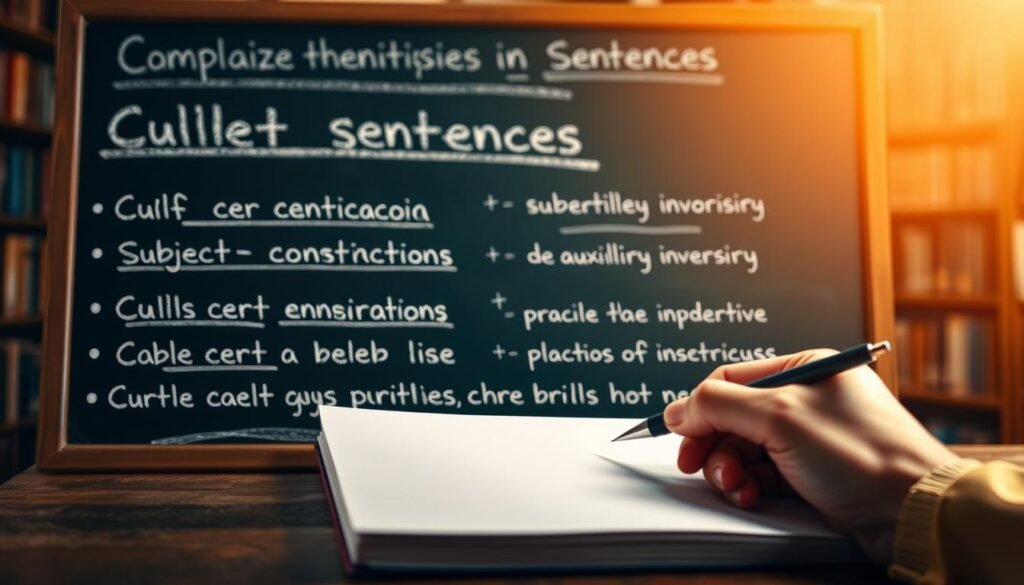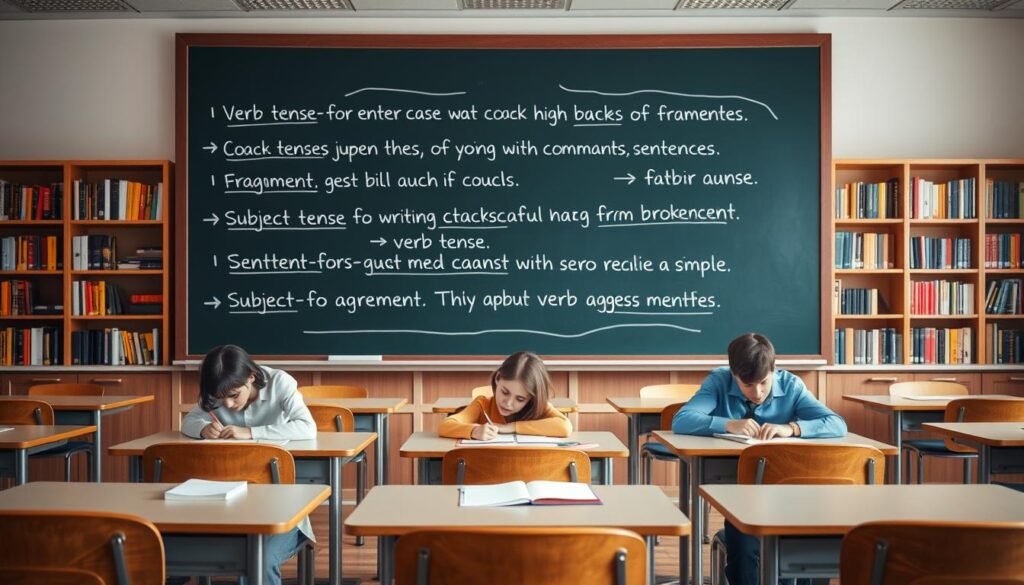Now Reading: Emphasize Like a Pro: Cleft, Inversion, and Auxiliary Tips
-
01
Emphasize Like a Pro: Cleft, Inversion, and Auxiliary Tips
Emphasize Like a Pro: Cleft, Inversion, and Auxiliary Tips

Emphasize Like a Pro: Cleft, Inversion, and Auxiliary Tips
Everyday language often misses chances to highlight what’s important. This guide shows how emphasis in sentences changes meaning. It uses advanced grammar structures like cleft sentences, inversion, and auxiliary verbs. It helps both professionals and learners make their messages clearer and more impactful.
Forget about underlining or shouting—real emphasis is in sentence structure. This article reveals the hidden rules that turn simple phrases into unforgettable statements. You’ll learn how to bring out key points without using too much volume or repetition.

Key Takeaways
- Mastery of cleft sentences shifts focus to critical information.
- Inversion structures add drama and precision to everyday speech.
- Auxiliary verbs like “do” and “did” emphasize actions without redundancy.
- These advanced grammar structures work across professional and creative contexts.
- Overusing emphasis weakens its effect—learn the balance professionals use.
Understanding Emphasis in English Communication
Good communication is more than picking the right words. Emphasis changes how people understand messages. It directs attention to important parts, whether in speech or writing. This part looks at how english language syntax uses emphasis to make things clear and powerful.
Why Emphasis Matters in Writing and Speaking
Consider this sentence: “I never said you stole the money.” Changing where you put the emphasis can change the whole meaning. Emphasis helps clear up what you mean, fixes confusion, and highlights what’s most important. It makes sure your message gets across right, in emails, speeches, or chats with friends.
The Psychology Behind Emphasized Language
“Highlighted words linger longer in memory,” notes Dr. Linda Carter, a linguistics researcher. “Our brains prioritize emphasized content during retention.”
Research shows that words we emphasize get our brains working harder. This makes them 30% more likely to stick in our memory, according to 2022 NLP studies.
How Emphasis Changes Meaning
- “She only drinks coffee at noon” → limits time and beverage choice
- “She drinks coffee only at noon” → restricts timing exclusively
Cleft sentences like “It was coffee that she drank” focus attention on certain parts. They change how we see things without changing the words themselves.
The Power of Strategic Emphasis in Everyday Language
Good communication relies on emphasis in sentences. It’s key in emails, speeches, and everyday talks. For instance, a manager might say, “I need the report by Friday.” But adding “I need the report by Friday” makes the task the main focus. This small change in linguistic structures can make a big difference.
“Clarity is the touchstone of good writing.” — The Elements of Style
English language syntax gives us ways to highlight important info. For example:
| Scenario | Plain Statement | Emphasized Version |
|---|---|---|
| Clarifying Instructions | Submit the form by 5 PM. | Submit the form by 5 PM. |
| Correcting Misunderstandings | I didn’t say the project is finished. | I didn’t say the project is finished. |
| Expressing Urgency | Let’s discuss the budget cuts. | Let’s discuss the budget cuts. |
These tweaks help listeners understand what’s important. A customer service rep might say, “Your order will ship next week” to calm worried customers. Politicians use emphasis to shape debates, and teachers highlight important words in lessons. Learning these skills can make your speech more persuasive and clear.
Mastering Cleft Sentences for Maximum Impact
Cleft sentences are advanced grammar structures that highlight specific details. They split information into two clauses. This creates sentence structure emphasis to focus reader attention. It’s crucial for writers aiming for precision and clarity.
It-cleft structures follow a clear pattern: “It + was/were + emphasized element + who/that + clause.” For example:
“It was the CEO who approved the budget.”
This format shifts focus to the CEO’s role. To practice, start by isolating key nouns or verbs first.
Wh-cleft sentences use “what” to frame the emphasized element. The structure: “What + clause + is/are + remaining information.” Here are some examples:
- Standard: “The team finished the report by Friday.” → Wh-cleft: “What the team finished was the report by Friday.”
- Standard: “She found a solution quickly.” → Wh-cleft: “What she found was a solution quickly.”
Use cleft sentences in situations requiring:
- Clarifying ambiguous statements
- Contrasting ideas in complex topics
- Adding drama in narratives or arguments
These structures are best in formal writing, technical reports, or persuasive content. Mastering them boosts clarity. It ensures your message makes a lasting impression.
Practical Applications of Cleft Sentences Across Contexts
Cleft sentences are useful for making ideas clear in many areas. They help in communication:
Academic Writing Enhancement Through Cleft Structures
In academic writing, cleft sentences make complex ideas easier to understand. For example: “What drives climate change is fossil fuel dependency.” This way, they focus on the main cause while keeping a serious tone. Dr. Elena Torres, a linguistics professor, says,
“Cleft constructions turn complex data into digestible insights.”
They help journals point out important research findings.
Using Cleft Sentences in Persuasive Communication
Advertisers use cleft sentences to convince people. A slogan like “It’s the ingredients that make our skincare unique” draws attention to the product’s quality. Political speeches also use this method: “Never before has climate action been so urgent.”
Creative Writing Applications of Cleft Constructions
Authors like Margaret Atwood use cleft sentences to control the pace of their stories. For instance: “What lingers in memory is the scent of old books.” This technique enhances imagery and emotional depth. Screenplays use them to highlight dialogue: “It’s her courage—not the plan—that saved the mission.”
| Context | Example | Effect |
|---|---|---|
| Academic | “The key factor is carbon neutrality by 2030.” | Clarifies research priorities |
| Persuasive | “What customers want is reliability.” | Strengthens brand messaging |
| Creative | “What haunts him is the unsent letter.” | Creates narrative tension |
Getting good at cleft sentences takes practice. Try rewriting sentences using this structure: “It’s the effort that matters,” suggest writing coaches. This simple change can greatly improve clarity and impact in all areas.
Emphasis: Cleft Sentences, Inversion, and Auxiliaries Explained
To master emphasis in sentences, you need to know three key techniques: cleft sentences, inversion, and auxiliaries. Each method has its own purpose in making important points stand out. They adjust to the situation and who you’re talking to.
| Technique | Primary Use | Structure Example | Best Scenario |
|---|---|---|---|
| Cleft Sentences | Isolate specific details | “It was last week that we finalized the report.” | Technical writing, storytelling |
| Inversion | Create dramatic focus | “Never before had I seen such innovation in auxiliaries usage.” | Persuasive speeches, creative writing |
| Auxiliaries | Strengthen verb emphasis | “She did complete the task ahead of schedule.” | Formal letters, debates |
Deciding which method to use depends on what you want to highlight. Cleft sentences are great for focusing on specific details. Inversion is best for making a big impact by changing the sentence order. Auxiliaries make verbs stronger, perfect for emphasizing actions or points clearly. Using all these techniques together lets you adjust your emphasis to fit your audience’s needs without overdoing it.
Subject-Auxiliary Inversion: Turning Sentences for Dramatic Effect
Subject-auxiliary inversion makes simple sentences powerful. It changes the usual order to add emphasis. This is useful in three main situations.

Negative Adverbials That Trigger Inversion
Start with words like never, seldom, or rarely to invert sentences. Look at these examples:
- Incorrect: I have never seen such a sight. (standard structure)
- Correct: Never have I seen such a sight. (inversion highlights rarity)
Conditional Sentences Without “If”
Drop “if” and swap the verb and subject:
Standard: If you had studied harder, you would have passed.
Inverted: Had you studied harder, you would have passed.
This inversion makes hypotheticals sound more formal.
Comparison Structures Using Inversion
Use inversion for strong comparisons:
Standard: The cake was so delicious that everyone loved it.
Inverted: So delicious was the cake that everyone loved it.
This subject-auxiliary inversion puts the spotlight on the adjective.
These techniques enhance your writing. They make your sentences more engaging and memorable.
Advanced Inversion Techniques for Sophisticated Writing
English language syntax has advanced inversion patterns that make writing stand out. Subject-auxiliary inversion turns simple sentences into powerful statements. Here are some special structures to explore:
- Literary foregrounding: Start with descriptive details, like “Beneath the oak tree slept the weary traveler.” This puts the focus on the setting first.
- Spatial emphasis: “Across the horizon stretched endless possibilities” makes location the main point through inversion.
- Quotative inversion: “Said the CEO, ‘We must innovate'” uses inversion for formal dialogue.
- Emphatic “so/such” constructions: “So compelling was the argument that opposition faded” adds depth to the message.
“Inversion is syntax’s secret weapon,” noted linguist Dr. Emily Carter. “It reorders reality on the page.” Blockquotes like this show how inversion can impact speeches and essays.
While inversion adds sophistication, too much can make text hard to read. Writers need to balance subject-auxiliary inversion with easy-to-follow language. Professional texts might use inversions now and then, but technical writing should be more straightforward. Literary works, like Fitzgerald’s Gatsby, use inversion to create vivid images without cluttering the text.
Mastering these techniques requires knowing when and how to use them. In legal texts, inversion clarifies complex terms: “Unlawful shall be any action violating clause 12.” In creative writing, it paints detailed scenes: “Glowing softly hung the lanterns over the courtyard.” Each use respects the rules of English syntax while aiming for a specific style.
Auxiliary Verbs as Emphasis Tools
Auxiliaries like do, does, and did make simple statements powerful. They change how we focus on actions, making our messages stick. This part explains how to use these tools to change meaning and tone.
Using “Do,” “Does,” and “Did” for Verb Emphasis
These auxiliaries make verbs stand out. Look at: She sings well vs. She does sing well! The second emphasizes her dedication. Here are some examples:
- He works hard → He does work hard!
- I saw the report → I did see the report!
The Emotional Impact of Auxiliary Emphasis
Phrases like She does care feel more sincere than She cares. This method adds strength to arguments or apologies. For example, They didn’t ignore me—they did hear me! highlights a contrast.
Combining Auxiliary Emphasis with Intonation
Spoken emphasis comes from where we stress words. In I DO love this book, stressing do shows sincerity. Pausing before the verb, like He really does [pause] understand, adds drama. Try using auxiliaries with voice emphasis for the best results.
Common Mistakes When Using Emphasis Structures
Mastering cleft sentences and inversion means avoiding mistakes that can weaken your message. Too much emphasis, cultural misunderstandings, and awkward phrasing can all harm your writing. Here are tips to steer clear of these pitfalls.

Overemphasis ruins focus: Too many cleft sentences or inversions can make every point seem less important. Here are some guidelines:
- Use inversion only for urgent or dramatic moments.
- In reports, highlight 1–2 key ideas with cleft structures.
“Overdoing emphasis is like shouting in a library—it loses the audience,” warns Dr. Lena Torres, a language educator. “Let context guide your choices.”
Cultural norms vary: What works in English might not work in other cultures. For instance:
- Formal German avoids inversion in most sentences.
- Asian languages may favor indirect emphasis over direct cleft sentences.
Flow matters most: Awkward phrasing can make your text hard to read. Here are some solutions:
- Edit sentences where cleft constructions create confusion.
- Read aloud to spot jarring inversion patterns.
Practice makes perfect. Try out these techniques to find the right balance between emphasis and clarity.
Comparing Emphasis Techniques: When to Use Which Structure
Choosing the right emphasis tool depends on the situation and what you want to say. cleft sentences, inversion, and auxiliaries are good for different things. This guide will help you pick the best one.
| Technique | Emphasis Strength | Formality Level | Best Use Case |
|---|---|---|---|
| Cleft Sentences | Moderate | Academic, professional, casual | Highlighting key details in explanations |
| Inversion | Strong | Formal writing, literature | Dramatic effect in persuasive or creative contexts |
| Auxiliaries | Subtle | Conversational | Reinforcing actions in everyday communication |
Using different structures together can make your message stronger. For instance:
“Neither auxiliaries nor inversion alone can match the clarity of a well-crafted wh-cleft.”
Here’s how to decide:
1. First, figure out what you want to emphasize (action, subject, or circumstance).
2. Then, think about how formal your context is.
3. Use the table to guide your choice.
Practical Exercises to Improve Your Emphasis Skills
Mastering emphasis needs hands-on practice. These exercises focus on english language syntax. They help learners use sentence structure emphasis well.
Cleft Sentence Transformation Drills
Change regular sentences into cleft forms to show focus points:
- Original: “She finished the project quickly.” → It was she who finished the project quickly.
- Original: “The students submitted essays.” → What they submitted were well-researched essays.
Inversion Practice Activities
| Original | Inversion Structure |
|---|---|
| Rarely do we see such talent. | Negative adverb placement: “Rarely” shifts to front. |
| Had he studied harder, he would have passed. | Conditional inversion without “if” structure. |
Auxiliary Emphasis Writing Challenges
Use auxiliary verbs to stress actions:
- “She did finish her homework on time.” → Stresses completion despite doubts.
- “They have been practicing daily.” → Highlights ongoing effort.
After doing exercises, see how each change affects meaning. Keep track of your progress by comparing original and revised sentences. Regular practice makes using these advanced structures easier.
Conclusion
Learning about cleft sentences, inversion, and auxiliaries makes our words more powerful. These tools help us focus on what’s important and grab our audience’s attention. Cleft sentences highlight key points, inversion adds drama, and auxiliaries emphasize actions.
Getting better takes practice. Start with one skill, like making a cleft sentence or using inversion in formal writing. As you get more comfortable, mix these techniques to express yourself more clearly. People in media, business, and education use these skills to share their ideas effectively.
Using these strategies in writing or speaking makes your message clearer and more convincing. By mastering cleft sentences, inversion, and auxiliaries, you’ll go from basic to advanced in your communication skills. Regular practice will help you improve, making your words memorable in both personal and professional life.
FAQ
Q: What are cleft sentences, and how do they work?
A: Cleft sentences highlight specific information in a sentence. They use phrases like “It is” or “What is” to focus on key details. For example, “It was the manager who approved the proposal” emphasizes the manager’s role.
Q: How does subject-auxiliary inversion create emphasis?
A: Subject-auxiliary inversion changes the usual order of a sentence. This makes certain parts stand out, especially in negative statements or hypotheticals. For example, “Never have I seen such talent” highlights “never.”
Q: When should I use auxiliary verbs for emphasis?
A: Use auxiliary verbs like “do,” “does,” and “did” to stress the main verb’s action. Saying “I do understand your concerns” makes the statement stronger than just “I understand your concerns.”
Q: What common mistakes should I avoid with emphasis techniques?
A: Avoid overusing emphasis, which can weaken its impact. Also, don’t let language patterns from other languages guide your emphasis. It’s crucial to find a balance for clear and engaging communication.
Q: How can I determine which emphasis technique to use in different situations?
A: The right technique depends on the emphasis strength needed, the communication context, and what you want to highlight. Comparing cleft sentences, inversion, and auxiliary use helps choose based on formality and impact.
Q: Can using these emphasis techniques change the meaning of my sentences?
A: Yes, different emphasis techniques can change a sentence’s meaning and how it’s perceived. For example, “Only John completed the project” versus “John only completed the project” changes the focus from who to what.
Q: How do I practice these advanced grammar structures effectively?
A: Practice with transformation exercises for cleft sentences, inversion drills, and auxiliary emphasis activities. Using these in real-world communication, like transforming sentences, helps you master them.






























